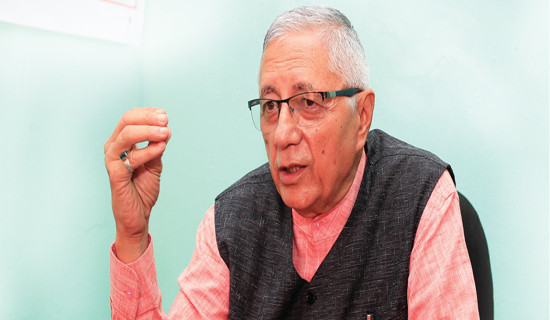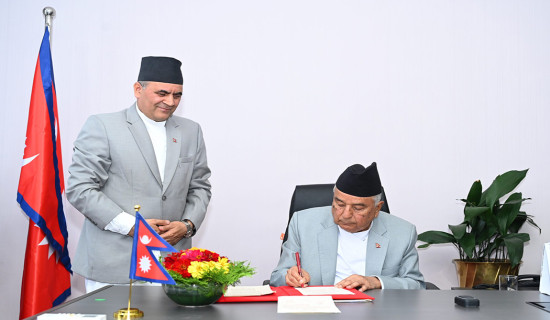- Saturday, 20 December 2025
Governing Norm For Provincial Budget
Provincial governments unveiled their budgets for the fiscal year 2024/25 last Saturday in adherence of the provision of law that fixes the date for the presentation of the budget to the provincial parliament. This year most of the provincial governments have reportedly slashed the quantum of their annual budget estimates due to, among others, reduced fiscal transfers from the federal government. However, a general scanning of budget statements indicate that the tendencies of budgetary appropriations on petty programmes and projects have not been corrected despite the reduction in the quantum of available meager public resources.
The most worrying part of the provincial budgetary allocation this year has been the allotment of the resources to support the projects selected and prioritised by lawmakers to nurse their respective constituencies. As reported, the Madhes Pradesh government headed by Janmat party has gone further ahead and presented the budget the other day, provisioning for direct earmarking of hefty amount of about fifty million rupees to lawmakers each for this fiscal year. This is being reportedly challenged in the court of law. Needless to say, Supreme Court has already invalidated such transfers of public resources to lawmakers emphasising that this violates the basic premises of the principle of check and balances. Parliamentarians irrespective of their level – federal, provincial and local – are expected to concentrate on lawmaking, not on executive and development functions.
Fund allocations
Needless to say, in most parliamentary democracies like ours, the constitution and relevant laws prescribe a central role to parliamentarians in providing inputs to governmental decisions as deputies of the people and overseeing their implementation. However, the parliamentarians are marginalised and sidelined even more so when it comes to decisions relating to public resources allocations. They do not possess enough resources, skills and capacity to hold executive to account and carry out the minimum oversight functions. It is therefore argued that the fund allocations can empower lawmakers by allowing them to spend money independently of the executive. Lawmakers claim that such allocations allow them to respond directly to basic demands and concerns of their constituents.
In fact, voters have developed certain unscheduled expectations of treating their lawmaker as a provider of development activities and financial assistance. This has created problems for those parliamentarians who are unable to respond adequately to such expectations. Lawmakers claim that such fund allocations help them to ensure project delivery in the face of ineffective local government institutions and structures. Budgetary provisions to support lawmakers can channel funding directly to community to enable the participation of the local population in project choices and carrying out of local infrastructure schemes they need. However, fund allocations for constituency area development breach the principle of the separation of powers by conferring parts of the executive function of budget execution on the legislature or lawmakers.
In fact, any outfit that comprises of members of parliament, and is charged with expenditure of public funds is commingling the roles of the different organs of state in a manner that is unacceptable in a multiparty democracy. A report dealing with the constituency development allocations widely practiced in African parliaments where Westminster model of democracy prevails says “Constituency development fund represents just another story of African corruption. When one considers evidence from countries with long-standing constituency development allocations, the real risks become clearer. The problem with such allocations is that they corrupt the relationship between MPs and their constituents and between parliament and the executive”.
Similarly, Commonwealth Parliamentary Association warned, not very long ago, that fund allocations to lawmakers for pork barrel projects could contribute to shifting the relationship between lawmakers and their constituents from political to financial basis. A study conducted in the Philippines not very long back found that because of such fund allocations to parliamentarians, more and more voters think lawmakers should be evaluated on their ability to bring in benefits to their constituency, not how effectively they make laws and contribute to the legislative deliberations. These examples show that constituency development allocations contribute to clientelism, reducing parliamentarians as being what is said as “automatic teller machines,” rather than representatives of the people in the governing process.
Fiduciary risk
According to a study conducted to audit and evaluate the use of the constituency area development fund in Nepal, there was no transparency in fund utilisation. As a result, the expenditures could not meet the actual needs and problems of the people. A sizeable amount remained unsettled, raising serious issues of fiduciary risk. Moreover, there have been some cases of duplication and overlapping of resources as the planning process defined in the rules and regulations was not followed properly. Nepal’s federal scheme entrusts local governments important constitutional mandates and competencies to carry out local infrastructure development which duplicates with the allocations provided to lawmakers in the name of constituency development.
The provincial governments should, therefore, give attention to devising alternative to the prevailing practice of short-term project benefits to lawmakers and some of their constituents. The focus should, therefore, lay on long-term task of reforming, capacitating, and empowering legislatures to influence government budget allocations, and prioritise the projects that deliver benefits to needy people in the far-off hinterlands of the country. Provincial parliament should also be enabled to hold the provincial executive to account for the implementation of the budget.
Such a long-term measure may not be attractive in the face of the fast and quick promises of the constituency development allocations. The evidence does, however, suggest that short-term pleasure of such allocations may result in long-term financial pain for the country. Moreover, as provincial structure in Nepal - a novel arrangement in the federal set up - has been questioned as an anathema, the subnational government should make wise use of public resources and demonstrate its effectiveness in delivering services to the people.
(The author is presently associated with Policy Research Institute (PRI) as a senior research fellow. rijalmukti@gmail.com)















